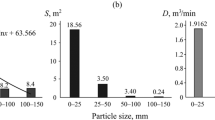On the understanding that the characteristics of the gas flow have a major contribution to slagging, a change in the fineness of pulverized coal necessitates taking into account the change in the properties of fly ash, which can either improve or worsen the slagging situation. A decrease in the pulverized coal particle size leads to a reduction of the fly ash particle size, an intensification of the formation of friable deposits, and an increase in the degree of conversion of pyrite to solid iron oxides. This reduces or prevents the formation of strong primary deposits and critical slagging situations. The smaller the dust particles, ceteris paribus, the lower the slagging rate. Unlike coarser pulverized coal, the strength of deposits increases due to sintering and decreases due to sulphatization.
Similar content being viewed by others
References
A. N. Alekhnovich, “Influence of pulverized-coal fineness on the slagging of boilers,” Élektr. Stantsii, No. 10, 2 – 7 (2015).
J. M. Beer, A. F. Sarofim, and L. E. Barta, et al., Transformation of Coal Mineral Matter during Pulverized Coal Combustion. Final Report, Massachusetts Institute of Technology, Cambridge, MA, USA (1992).
L. Ya. Skryabina, Atlas of Industrial Dusts. Part I. Fly Ash of Thermal Power Plants [in Russian], Izd. TsINTIKhIMNEFTEMASh, (1980).
E. Raask, “Flame imprinted characteristics of ash relevant to boiler slagging, corrosion, and erosion,” Trans. ASME J. Eng. Power, 104(4), 858 – 866 (1982).
A. N. Alekhnovich, “Initial slagging temperature as a coal slagging index: Determination and application. Part 1,” Power Techn. Eng., 48(3), 210 – 217 (2014).
E. Raask, “Verschlackungen in steinkohlegefeuerten Kesseln-Verschlackungsmechanismus und Verhutungsmassnahmen,” VGB Kraftwerkstechnik, 53(4), 248 – 254 (1973).
V. V. Kharchenko, I. K. Lebedev, and M. F. Lebedeva, “Role of coagulation of fine particles of calcium oxide in the slagging mechanism on heating surfaces,” in: Proc. 3rd All-Union Conf. on Influence of the Mineral Part of Power-Generating Fuels on the Operating Conditions of Steam Generators [in Russian], Tallinn (1980), pp. 125 – 131.
F. Voros, “Salaklerakodasi folyamatok vizsgalatareakcio kinetikai kiserleti berendezesen,” Energia es Atomtechnika, XXXIV(2), 56 – 62 (1981).
R. E. Mitchell, Mechanisms of Pyrite Oxidation to Nonslagging Species. Final Report DE-FG22-94PC94205, Stanford University, Stanford, California, USA, September (2002) (www.osti.gov/scitech/servlets/purl/812007).
A. N. Alekhnovich, “Formation and characteristics of coal fly ash: Variation in the characteristics of fly ash along the gas path of a boiler. Part 2,” Élektr. Stantsii, No. 12, 11 – 15 (2012).
E. Raask and K. S. Vores (eds.), “Deposit constituent phase separation and adhesion,” in: Mineral Matter and Ash in Coal, ACS Symposium Series 301, American Chemical Society, Washington (1986).
Author information
Authors and Affiliations
Corresponding author
Additional information
1This study was sponsored by the Russian Foundation for Basic Research (project No. 15-08-06422_a).
Translated from Élektricheskie Stantsii, No. 4, April 2016, pp. 17 – 22.
Rights and permissions
About this article
Cite this article
Alekhnovich, A.N., Chernetskiy, M.Y. & Bogomolov, V.V. Effect of the Fineness of Pulverized Coal on the Slagging and Fouling Properties of Fly Ash1 . Power Technol Eng 50, 313–317 (2016). https://doi.org/10.1007/s10749-016-0703-x
Published:
Issue Date:
DOI: https://doi.org/10.1007/s10749-016-0703-x



